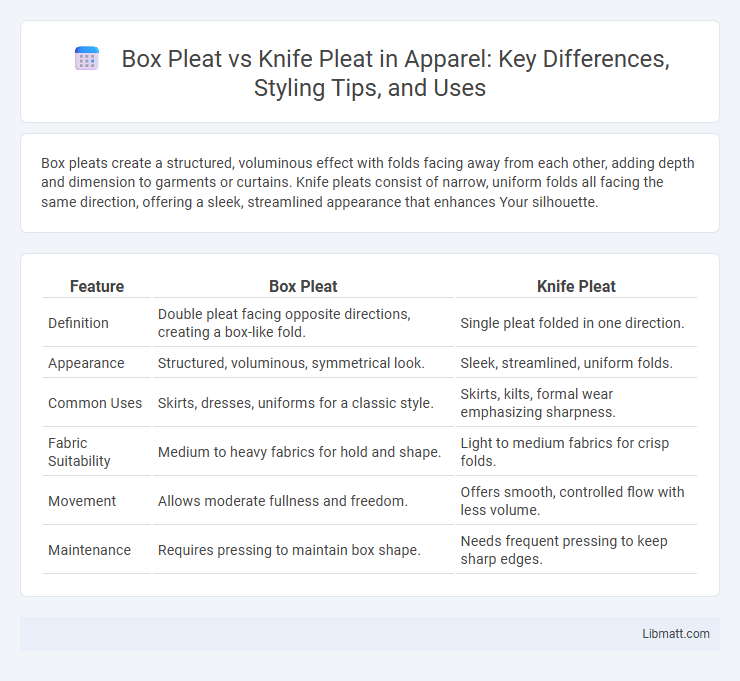Box pleats create a structured, voluminous effect with folds facing away from each other, adding depth and dimension to garments or curtains. Knife pleats consist of narrow, uniform folds all facing the same direction, offering a sleek, streamlined appearance that enhances Your silhouette.
Table of Comparison
| Feature | Box Pleat | Knife Pleat |
|---|---|---|
| Definition | Double pleat facing opposite directions, creating a box-like fold. | Single pleat folded in one direction. |
| Appearance | Structured, voluminous, symmetrical look. | Sleek, streamlined, uniform folds. |
| Common Uses | Skirts, dresses, uniforms for a classic style. | Skirts, kilts, formal wear emphasizing sharpness. |
| Fabric Suitability | Medium to heavy fabrics for hold and shape. | Light to medium fabrics for crisp folds. |
| Movement | Allows moderate fullness and freedom. | Offers smooth, controlled flow with less volume. |
| Maintenance | Requires pressing to maintain box shape. | Needs frequent pressing to keep sharp edges. |
Understanding Box Pleats and Knife Pleats
Box pleats create a structured, symmetrical look by folding fabric in opposite directions to form a rectangular shape, often adding volume and dimension to skirts or curtains. Knife pleats consist of multiple narrow folds all facing the same direction, generating a sleek and uniform appearance commonly used in school uniforms and formalwear. Understanding these pleat types helps in selecting the appropriate style for desired texture, movement, and garment silhouette.
Key Differences Between Box Pleat and Knife Pleat
Box pleats feature fabric folds that meet evenly on both sides, creating a squared, structured appearance ideal for skirts and curtains, while knife pleats consist of sharp, narrow folds all facing the same direction, offering a sleek, uniform look commonly seen in uniforms and formal wear. The depth and width of box pleats tend to be wider and more pronounced, providing volume and dimension, whereas knife pleats are tighter and more subtle, contributing to an elegant drape without bulk. Understanding these key differences can help you choose the perfect pleat style to match your design needs and fabric behavior.
Visual Characteristics of Each Pleat Style
Box pleats create a structured, symmetrical appearance with fabric folding inward on both sides, producing a rectangular shape that adds volume and a tailored look to garments. Knife pleats consist of sharp, narrow folds all facing the same direction, offering a sleek, uniform texture that enhances fluid movement and light reflection. Your choice between box pleats and knife pleats impacts the visual depth and style, balancing between structured formality and dynamic elegance.
Fabric Choices for Box Pleats and Knife Pleats
Box pleats work best with medium to heavy fabrics like wool, denim, or twill, as their structure requires enough weight to hold the sharp, squared folds firmly. Knife pleats are ideal for lighter to medium-weight fabrics such as chiffon, silk, or polyester, allowing for fluid movement and crisp, narrow folds. Selecting the right fabric for your pleat style enhances durability and the overall aesthetic of your garment.
Common Uses in Fashion and Home Decor
Box pleats create a structured, voluminous look often used in skirts, dresses, and tailored home decor items like curtains and cushion covers. Knife pleats offer a sleek, elegant appearance common in school uniforms, formalwear, and window treatments where a clean, streamlined effect is desired. Your choice between box pleats and knife pleats can significantly impact the garment or room's texture and visual depth.
Ease of Construction: Sewing Techniques Compared
Box pleats require folding fabric in opposite directions, creating a structured, symmetrical look that demands precise measuring and pinning, making them moderately challenging for beginners. Knife pleats consist of multiple folds all facing the same direction, allowing for quicker and simpler sewing techniques, ideal for those seeking ease and speed in construction. Your choice between box pleats and knife pleats will depend on your sewing skill level and the desired garment structure.
Durability and Maintenance Considerations
Box pleats, characterized by their folded fabric structure, offer enhanced durability due to their thicker, reinforced pleat formation that resists wear and maintains shape under frequent use. Knife pleats, featuring sharp, narrow folds all facing one direction, may require more frequent maintenance to prevent fabric distortion and ensure pleat crispness, especially on delicate materials. Proper care for both pleat types includes regular steaming and gentle handling to extend garment longevity and preserve pleat integrity.
Styling Tips: When to Choose Each Pleat
Box pleats create structured volume and work best in tailored skirts or dresses for a polished, classic look suitable for professional or formal occasions. Knife pleats offer a sleek, flowing silhouette that complements casual and feminine styles, perfect for adding movement in skirts or dresses ideal for everyday wear or evening events. Choose box pleats to emphasize shape and rigidity, while knife pleats are ideal for lightweight fabrics and garments emphasizing fluidity.
Pros and Cons of Box Pleats vs Knife Pleats
Box pleats offer a structured, voluminous look that provides durability and a classic aesthetic, making them ideal for skirts and upholstery, but they can add bulk and limit fabric movement. Knife pleats create sharp, uniform folds that allow fluid motion and a slimming silhouette, suitable for modern fashion and draping, yet they can crease easily and require frequent maintenance. Choosing between box pleats and knife pleats depends on the desired garment style, fabric type, and wearability preferences.
Frequently Asked Questions About Pleat Types
Box pleats create a squared, structured look by folding fabric in opposite directions, while knife pleats involve sharp, narrow folds all facing the same direction for a streamlined appearance. Common questions include which pleat offers better volume and movement, with box pleats providing more fullness and knife pleats lending a sleek, tailored effect. Care instructions also differ; box pleats typically require less frequent pressing, whereas knife pleats need consistent maintenance to keep their crisp edges.
Box pleat vs knife pleat Infographic

 libmatt.com
libmatt.com